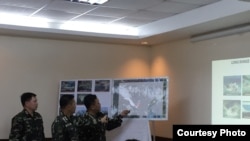Joint military exercises involving a larger than usual number of United States and Philippines troops get underway in the Philippines today amid concerns about China’s expansive reclamation work in the disputed waters of the South China Sea.
Philippine and American officers at the Philippine military’s general headquarters in Metro Manila unfurl a satiny white flag marking the start of joint exercises they say are larger and “more complex” than in years past.
A little more than 5,000 Philippine troops and some 6,500 U.S. troops are involved. Philippine Exercises Assistant Director, Brigadier General Rodolfo Santiago said usually only 6,000 to 8,000 total participate yearly. “But if you’ll see the trend it is really increasing every year. And as I’ve said, it is a natural progression of the maturing capability development level, the level of the capability is equivalent to the complexity of the operation and the exercise that we do,” he stated.
Santiago’s U.S. counterpart, Brigadier General Christopher Mahoney, said this year’s exercises involving amphibious landings, live fire drills and maritime surveillance are more sophisticated and more involved than in the past.
But this year was also supposed to mark the start of a new defense agreement that would see more U.S. troops rotating through the Philippines, and the prepositioning of their military assets at select Philippine bases. The two countries’ Enhanced Defense Cooperation Agreement, signed in April last year, is not yet being implemented because of challenges to its constitutionality in the Philippines high court.
Philippine National Defense Secretary Voltaire Gazmin pointed out the hindrance during an opening ceremony speech. “We shall undertake this exercise as we work towards operationalizing- if permitted by our Supreme Court- the Enhanced Defense Cooperation Agreement, which would enable us to conduct combined exercises more efficiently and effectively,” Gazmin said.
Without being specific, a Philippine Armed Forces spokesman told VOA there are some exercises that the group would have wanted to include in this year's joint drills if not for the pending decision.
Carl Baker is director of programs at the Pacific Forum of the Center for Strategic and International Studies, a Washington, D.C. security think tank. He said even without the agreement in force, both countries are still able to benefit. “The real shift, and probably why they’re bringing in more troops, is the United States and the Philippines have both said it’s important to demonstrate that the Philippines is shifting its focus from internal to external defense and that, of course, requires more troops and requires probably a larger defense posture by the United States,” he said.
The agreement reinforces U.S. efforts to more intentionally shift its strategic sights toward Asia. It also reinforces the Philippines' minimum credible defense stance in the face of a dispute with China over features in the South China Sea.
While military officials from both the U.S. and the Philippines say the exercises do not target any one specific country, Baker calls the increased troop levels a “low-key response without being overly provocative” to an ever more assertive China in the South China Sea.
China has become quite visible in the disputed waters in recent years with regular patrols, drilling activity and now construction on contested outcroppings, all while reiterating “indisputable sovereignty” over the sea and its hundreds of features. The Philippines, Vietnam, Brunei, Malaysia and Taiwan also have overlapping claims.
Most recently, China has undertaken reclamation work at seven disputed reefs that the Philippines also have claims in the Spratly Islands. Hours before the opening of the joint exercises, Philippine Armed Forces Chief General Gregorio Pio Catapang released photos taken April 11th of the dramatically expanded outcroppings. “This will really greatly affect the movement of our fishermen, the movement of our Coast Guard and of course the movement of our Navy,” he explained.
The main concerns for Manila are the two reefs that are in close proximity to their occupied outcroppings. **Reclamation work started on Mischief Reef, which is very near Second Thomas Shoal, where a tiny Philippine contingent is based on a rusted old grounded ship. An airstrip appears to be taking shape at the other, Subi Reef, which Catapang said is about 75 kilometers from Thitu Island, where 150 (Philippine) civilians live.
Beijing has said its reclamation is not targeted at any one country. Furthermore it said it is well within its rights to build on its sovereign territory and that the development is for civilian needs and “the need for necessary military defense.”
**In an earlier version of this story VOA said Mischief Reef has a nearly completed airstrip. We regret the error.







